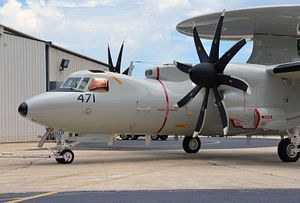The Japanese government has greenlighted the purchase of nine E-2D Advanced Hawkeye (AHE) Airborne Early Warning and Control (AEW&C) aircraft from the United States, Japan’s Defense Minister, Takeshi Iwaya, said on October 12.
“The E-2C aircraft are expected to retire (…) in the coming 10 years, and thinking about the severe security environment, it is absolutely necessary to replace them with the E-2Ds, which have more capabilities,” Iwaya said during a press conference.
The U.S. Department of State approved the possible sale of the aircraft last month.
The Japan Air Self Defense Force (JASDF) maintains a fleet of 13 E-2C Hawkeyes and four E-767 aircraft as part of its Airborne Early Warning Wing. The E-2Cs are all slated to be phased out of the service by the late 2020s.
The $3.135 billion procurement will be reflected in Japan’s National Defense Program Guidelines (NDPGs), which lays out the Ministry of Defense’s (MoD) defense programs including equipment procurement for the next ten years beginning in fiscal year 2019, as well as the government’s Mid-Term Defense Plan (MTDP), which covers the fiscal years 2019 to 2023.
The E-2D Advanced Hawkeye aircraft, designed and manufactured by Northrop Grumman, is a twin-turboprop, carrier-capable tactical airborne early warning aircraft. The E-2D is the latest version of the aircraft series equipped with an AN/APY-9 radar, an ultra-high frequency hybrid mechanical/electronically scanned radar system with a 360-degree coverage capability.
The E-2D was designed to help defend aircraft carrier strike groups (CSG) against any type of long-range aerial threats, with each CSG deploying four E-2Cs or E-2Ds. According to Northrop Grumman, the E-2D is capable of detecting a ground-to-air cruise missile launch and stealth aircraft.
As I explained in September:
Notably unlike U.S. Navy E-2Ds, Japanese E-2D aircraft will not be equipped with the so-called cooperative engagement capability (CEC), a real-time “sensor-netting” system, which allows “the real-time sharing of sensor data on air targets, including incoming enemy aircraft and cruise missiles, among CEC-equipped units,” as I noted elsewhere.
(The Japan Maritime Self Defense Force’s two improved Atago-class guided missile destroyers will reportedly be equipped with CEC, enhancing the ships’ ballistic missile defense capabilities.)
The [JASDF] will also base its aircraft on land allowing it to take off with extra fuel, which will allow the service to operate the aircraft for up to 8 hours, instead of a standard 5 hours (without refueling).
Japan’s MoD selected the E-2D in 2014 to improve the JASDF’s AEW&C capabilities. It already placed a $1.7 billion order for four E-2Ds in 2015, the first of which is currently undergoing flights tests at a test facility in Florida. The first E-2D is expected to be delivered by the end of 2019.
The JASDF is expected to station its future fleet of 13 E-2Ds at Misawa Air Base in Aomori Prefecture in the northernmost part of Honshu.

































